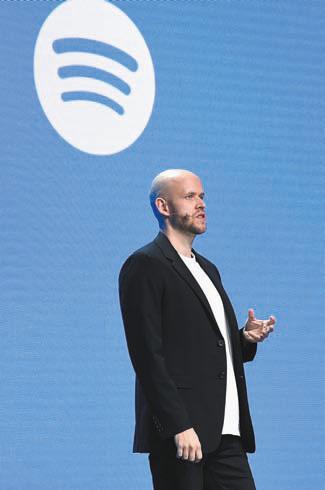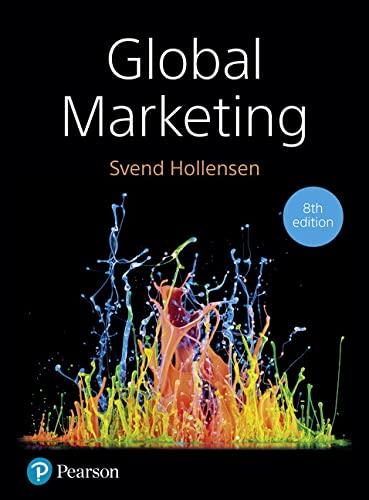Spotify (the brandname is a combination of spot and identify) is a digital music-streaming service that was
Question:
Spotify (the brandname is a combination of ‘spot’ and ‘identify’) is a digital music-streaming service that was launched in Sweden in 2008. Spotify was founded by Swedish Daniel Ek (see picture below) and Martin Lorentzon.
The company provides on-demand access to millions of songs which can be accessed on a range of devices. Unlimited users can listen to unlimited music on their desktop or laptop with no ads. Premium users can listen without advertisements or limits on all supported devices, including smartphones, tablets, and TVs. Around 70 per cent of Spotify’s total revenues (including those from advertising and subscription fees) go to rights holders, including artists, labels, and publishers. Despite Spotify’s success, the service faces competition from a host of other streaming services, for example, Apple, Pandora, Amazon and Deezer.
Spotify (www.spotify.com) principally operates under the so-called ‘freemium’ model: basic services are free and more advanced, or additional features are offered at a premium. This is augmented by income

from music purchases within the player. As of 2018, Spotify offered a US$10 per month unlimited subscription package on all platforms (desktop, tablet and smartphone).
Streaming of music
Streaming is a method of delivering media to an end user. As opposed to downloading, whereby an end user downloads a file, streamed music is readily available in ‘real time’ to the listener, and is transferred as a continuous stream of data. Unlike in the case of downloading, it is difficult for users of streaming services to save the content and potentially illegally distribute it.
Streaming requires a broadband or internet connection capable of transferring the data fast enough.
In order to minimize the bandwidth used, files encoded for streaming are often highly compressed.
Audio and video players, such as Quick Time and Adobe Flash Player, tend to retrieve extra data faster than they play it. In order to reduce the problem of the audio or video stopping due to internet problems, extra data is stored as a ‘buffer’. However, when the data runs out, the stream will stop and display a ‘buffering’ message.
The world global music industry
The revenues in the global music industry are now growing again after some years of stagnation. In 2018 global music sales grew for the third consecutive year with streaming now the single largest revenue source for the record industry. The worldwide streaming of music represents a value of approximately US$8.5 billion out of the total global music revenues of approximately US$22 billion. By the end of 2018, streaming accounted for 40 per cent of the total global music revenues.
Streaming is now established as the most prevalent and significant format in the modern music industry, fuelling growth in almost all major markets and starting to unlock the phenomenal potential within developing territories. Physical sales remain significant in certain countries and for certain artists, and the vinyl come-back has been a headline grabber, but streaming is the growth driver that is revolutionizing the music business.
By the end of 2018, IFPI estimated that the number of paid subscription accounts (regarding all streaming providers) reached 200 million worldwide (ifpi, 2018).
This includes the rapid growth of family plans, where several members of the same household can share a family subscription.
One key factor driving growth is increased competition.
Spotify remains the global leader in streaming and Apple Music has made huge progress since its launch in 2015 – see also the overview of the market shares in 2017 (Table 1).
In China, Tencent Music Entertainment, owner of the country’s leading streaming services, QQ Music, Kugou and Kuwo, is seeing its paid subscriber numbers soar. Amazon, meanwhile, launched Amazon Music Unlimited, while Pandora announced plans for an on-demand service (which it has now launched) and iHeart introduced beta versions of the US iHeart-Radio Plus (US $4.99, enhanced ad-free radio listening)
and iHeartRadio All Access (US $9.99, radio + full streaming service). Alongside that, record companies reached licensing agreements with Soundcloud and many other smaller services......
Questions
You are hired as a marketing expert by the Spotify CEO in order to create better financial balance with a starting point in Spotify’s ‘DNA’ profile.
1. What are the main elements of Spotify’s competitive advantage? Do you think that Spotify has real core competences that are more powerful than competitors’ competences?
2. Discuss the three strategic initiatives regarding Spotify’s financial imbalance. Which of the three strategic initiatives would you recommend the Spotify management to put highest on the priority list?
3. Which ‘entry mode’ strategy would you suggest Spotify to use when penetrating the Indian music streaming market?
Step by Step Answer:






